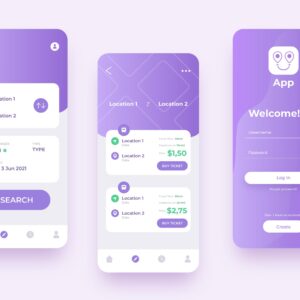In today’s digital era, a well-designed website is essential for businesses to thrive. Our services stand out by offering customized solutions, focusing on user experience and performance, and providing ongoing support to ensure your website remains a valuable asset in achieving your business goals.
Description
ECOMMERCE WEBSITE INCLUDES FOR YOU
Speciality: Selling products or services online.
Front-end: HTML, CSS, JavaScript.
Back-end: E-commerce platform (e.g., WooCommerce, Shopify).
Professionals involved: Web designer, front-end developer, back-end developer, database administrator.
Man hours: High, as it involves product listings, payment processing, and inventory management.
Approximate rate: $5,000 – $50,000+ (can vary significantly depending on the scale and features required).
- Responsive Design: Explain that your websites are designed to adapt and look great on various devices, including desktops, tablets, and smartphones. This ensures a consistent user experience and broadens their reach to different audiences.
- User-Friendly Navigation: Emphasize the importance of intuitive navigation menus and organized content structure. A user-friendly website allows visitors to easily find the information they need, enhancing their overall experience.
- Engaging Visuals: Describe how your websites incorporate visually appealing elements such as high-quality images, videos, and graphics. Engaging visuals capture users’ attention and leave a lasting impression, increasing the chances of conversion.
- Clear Call-to-Action (CTA): Highlight the significance of prominent and well-designed CTAs throughout the website. Effective CTAs encourage visitors to take specific actions, such as making a purchase, subscribing to a newsletter, or contacting the client for more information.
- Search Engine Optimization (SEO): Explain that you optimize websites for search engines to improve their visibility and organic traffic. By implementing relevant keywords, meta tags, and optimizing page speed, you can help the client’s website rank higher in search engine results, leading to increased exposure.
- Content Management System (CMS): If applicable, mention that you provide a user-friendly CMS like WordPress or Shopify. A CMS enables clients to easily update and manage their website content without requiring extensive technical knowledge.
- Social Media Integration: Highlight the benefits of integrating social media platforms with the website. This integration enables visitors to share content, increases brand visibility, and drives traffic from social media channels.
- Analytics and Reporting: Explain that you can set up analytics tools like Google Analytics to track website performance. Analytics provide valuable insights into user behavior, visitor demographics, conversion rates, and more, allowing the client to make data-driven decisions and refine their online strategy.
- Security Features(SSL Certification buy from client side): Emphasize that you prioritize website security to protect the client’s and their users’ data. Implementing SSL certificates, regular security updates, and secure payment gateways instills trust in visitors and reduces the risk of cyberattacks.
- Ongoing Support and Maintenance(Monthly through contract bases optional): Highlight your commitment to providing ongoing support and maintenance services. Assure the client that you’ll be available to address any issues, perform updates, and keep their website running smoothly.
- Website programming languages: HTML, CSS,JAVASCRIPT, BOOTSTRAP, REACT JS, ANGULAR JS, WORDPRESS, TAILWIND CSS, PYTHON, DJANGO, NODE JS, PHP These are the latest technologies are used in for create awesome designs.
- User Registration and Accounts: Allow users to create accounts and manage their personal information, order history, and preferences.
- Product Catalog: Display a well-organized catalog of products, including product images, descriptions, prices, and availability.
- Shopping Cart: Provide a virtual shopping cart where users can add products, view a summary of their selected items, and proceed to checkout.
- Secure Payment Processing: Integrate secure payment gateways to facilitate online transactions, ensuring the safety of customer payment information.
- Multiple Payment Options: Offer a variety of payment methods, such as credit/debit cards, PayPal, Apple Pay, or other digital wallets, to accommodate different customer preferences.
- Search Functionality: Implement a search bar to help users quickly find specific products or browse by categories, brands, or other filters.
- Product Reviews and Ratings: Allow customers to leave reviews and ratings for products, which can help build trust and assist other shoppers in making purchasing decisions.
- Order Tracking: Enable customers to track the status of their orders, including shipping details and estimated delivery dates.
- Wishlist and Favorites: Allow users to create and manage wishlists or mark products as favorites for future reference or easy access.
- Social Media Integration: Incorporate social media sharing buttons or links to allow users to share products with their social networks, increasing visibility and potentially driving more traffic to the website.
- Discount and Promotion Management: Implement features to create and manage discounts, coupon codes, promotional campaigns, and special offers to attract customers and increase sales.
- Responsive Design: Ensure the website is optimized for various devices and screen sizes, providing a seamless shopping experience on desktops, laptops, tablets, and mobile devices.
- Customer Support: Provide customer support options, such as live chat, email, or phone support, to assist users with inquiries, issues, or order assistance.
- Order History and Reordering: Enable users to view their past orders, making it easier for them to reorder products they have previously purchased.
- Shipping and Tax Calculation: Integrate shipping and tax calculators to provide accurate cost estimates during the checkout process.
- Security Measures: Implement SSL certificates, encryption, and other security measures to protect customer data and ensure secure transactions.
- Newsletter Subscription: Offer a newsletter subscription option to allow customers to receive updates on new products, promotions, and company news.
- Cross-selling and Upselling: Implement features that suggest related or complementary products to customers, encouraging them to make additional purchases.
- Localization and Multi-language Support: Provide options to switch between different languages and support multiple currencies to cater to an international customer base.
- Analytics and Reporting: Integrate analytics tools to track website traffic, customer behavior, conversion rates, and other key metrics, helping the client gain insights into their eCommerce performance.
- For more details about our work please refer previous worksApostrofo.liveEmcoreme.com
Artstories.in- Ecommerce
Tangenlabs.in
Gatewayerp.com





